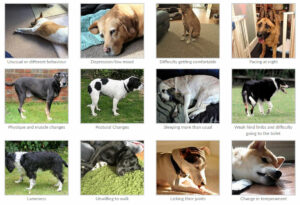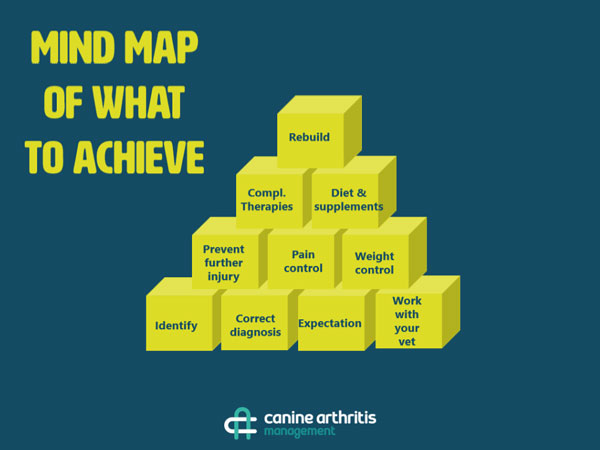Barks Blog
Is My Dog in Pain?
By Robyn Lowe

Every single dog is unique and every arthritis story is different. Some dogs are stoic and will hide symptoms and others will show very early on that they are in pain. We know that dogs all experience pain differently, X-rays may look horrendous on one dog but clinically they are still fairly mobile whereas X-rays on another may show very mild changes but the dog clinically is extremely painful!
Dogs do tend to tell us about chronic pain in a very different way to acute pain.
Acute pain – Is an emergency strategy to help remove from a noxious stimulus, to run away (fight or flight), to protect the body! Acute pain is self-limiting and is provoked by a specific disease or injury and as stated above serves a useful biologic purpose, in essence to PROTECT us.
Chronic pain – Chronic pain, in contrast, may be considered a disease state; it’s something that happens over time. With chronic pain there are changes in the brain and spinal cord that can cause pain ‘wind up’, causing exaggerated pain response. The pain outlasts the normal or usual time of healing and is associated with a disease or injury. Sadly it serves no biologic purpose, and has no recognisable end-point which is why it extremely important to manage it to the best of your ability for your dogs quality of life.
I think the take home message is that a dog suffering from CHRONIC pain will not always cry, vocalise, go completely non-weight baring on a limb. The signs are often so subtle that we often miss them, or dismiss them as ‘slowing down’ or ‘old age’. We don’t believe in such words here at CAM.
Here are some tips/signs on what to look for when looking for pain indicators in your dogs;
- Change in behaviour… Has your dog got grumpier? Less tolerant? Training going to pot? Fear reactive? This could be a defence mechanism to prevent pain. They are anticipating that that big bouncy puppy is going to jump on them and that HURTS.
- Changes in routine… are they not wanting to get up in morning? Are they not asking for walks as much? Sleeping more than usual?
- Are they more withdrawn and depressed than usual? Not greeting you at the door with a wagging tail?
- Has their wake/sleep cycle changed? Are they pacing at night? But then depressed and sleepy during the day?
- Are they moving and shuffling around when trying to get comfy?
- Are they licking joints? Looking at a certain area?
If you feel that your dogs are showing any signs of chronic pain, then we always advise to follow our pyramid:
First… identify. You can do this by looking out for our pain indicators and identifying that there is an issue.
Then get the correct diagnosis, and manage your expectations of the disease. Then working with your vet get in control of the pain; this is why it is central of our pyramid, because it is essential and central to all other interventions.
Once interventions are in place how quick should we see change?
You may see quick improvement of symptoms and behaviour changes. Other changes require a bit longer taking effect. You may be happy to see that over the coming months after diagnosis and starting a medication regime alongside other multimodal interventions that your dog becomes happier, livelier, wants to walk again, asks to play with toys, that their sleep improves and that their posture and physical changes improve too.
From a personal perspective of a dog with arthritis, following a medication regime, and help from a physiotherapist and laser therapy my dog is:
- Less grumpy
- Better at listening to cues
- Asking to play with toys much more in the day and evening
- Not asking to stop on walks
- Less fear reactive of dogs while walking
All these things make for a much happier dog and owner!
Resources
Identifying Pain: https://caninearthritis.co.uk/what-is-arthritis/identifying-signs
Chronic Pain Indicator Chart: https://caninearthritis.co.uk/wp-content/uploads/2017/03/Chronic-Pain-Indicator-Chart-V1.pdf
About the Author
Robyn Lowe of of PPG corporate partner Canine Arthritis Management is a Registered Veterinary Nurse who qualified with a degree from Myerscough School of Veterinary Nursing in Preston, England, in 2016 and started her RCVS Diploma in Advanced Veterinary Nursing in 2018. She has worked on a volunteer basis with animals since she was four and her passion for the profession has only grown since then. She spent years of her life at the Horse and Pony Protection Association (HAPPA) and later at a local rescue and rehabilitation yard. Here she met a veterinary surgeon who inspired her, and went for her first work experience in 2008 at their busy mixed practice. She has also travelled to Thailand to volunteer her knowledge and skills working with elephants, horses, goats, pigs, water buffalo, cats and dogs. She loves osteoarthritis clinics and using multimodal approaches to managing the condition, stating that it can be extremely rewarding seeing both owners and patients travel this extremely difficult journey together to improve quality of life for their pet.


